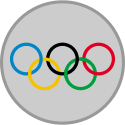Kristin Pudenz
| Data i miejsce urodzenia | ||||||||||||||||||||||||||||
|---|---|---|---|---|---|---|---|---|---|---|---|---|---|---|---|---|---|---|---|---|---|---|---|---|---|---|---|---|
| Dorobek medalowy | ||||||||||||||||||||||||||||
| ||||||||||||||||||||||||||||
Kristin Pudenz (ur. 9 lutego 1993 w Herford) – niemiecka lekkoatletka specjalizująca się w rzucie dyskiem.
Międzynarodową karierę rozpoczęła od brązu olimpijskiego festiwalu młodzieży w Tampere (2009). W 2015 sięgnęła po brąz młodzieżowych mistrzostw Europy w Tallinnie. Dwa lata później triumfowała na uniwersjadzie w Tajpej. Jedenasta zawodniczka mistrzostw świata w Dosze (2019). W 2021 zdobyła w Tokio wicemistrzostwo olimpijskie. Wicemistrzyni Europy z Monachium (2022).
Złota medalistka mistrzostw Niemiec.
Rekord życiowy: 67,87 (16 sierpnia 2022, Monachium).
Osiągnięcia
| Rok | Impreza | Miejsce | Pozycja | Wynik |
|---|---|---|---|---|
| 2009 | Olimpijski festiwal młodzieży Europy | 44,71 | ||
| 2013 | Młodzieżowe mistrzostwa Europy | 4. miejsce | 55,31 | |
| 2015 | Puchar Europy w rzutach | 1. miejsce (U-23) | 56,62 | |
| 2015 | Młodzieżowe mistrzostwa Europy | 59,94 | ||
| 2017 | Puchar Europy w rzutach | 6. miejsce | 57,77 | |
| 2017 | Uniwersjada | 57,25 | ||
| 2018 | Puchar Europy w rzutach | 4. miejsce | 59,06 | |
| 2019 | Mistrzostwa świata | 11. miejsce | 57,69 | |
| 2021 | Igrzyska olimpijskie | 66,86 | ||
| 2022 | Mistrzostwa świata | 11. miejsce | 59,97 | |
| 2022 | Mistrzostwa Europy | 67,87 |
Bibliografia
- Kristin Pudenz, [w:] tilastopaja.eu [online] [dostęp 2021-08-09] (ang.).
- Profil zawodniczki na stronie World Athletics (ang.) [dostęp 9 sierpnia 2021].
Media użyte na tej stronie
Pictograms of Olympic sports – . This is an unofficial sample picture. Images of official Olympic pictograms for 1948 Summer Olympics and all Summer Olympics since 1964 can be found in corresponding Official Reports.
Flaga Finlandii
Flag of Portugal, created by Columbano Bordalo Pinheiro (1857-1929), officially adopted by Portuguese government in June 30th 1911 (in use since about November 1910). Color shades matching the RGB values officially reccomended here. (PMS values should be used for direct ink or textile; CMYK for 4-color offset printing on paper; this is an image for screen display, RGB should be used.)
Autor: Pedro A. Gracia Fajardo, escudo de Manual de Imagen Institucional de la Administración General del Estado, Licencja: CC0
Flaga Hiszpanii
Chinese Taipei Olympic Flag. According to the official website of Chinese Taipei Olympic Committee, Blue Sky(circle) & White Sun(triangles) above the Olympic rings is neither the National Emblem of the Republic of China, nor the Party Emblem of Kuomintang (KMT), but a design in between, where the triangles do not extend to the edge of the blue circle, as registered at International Olympic Committee in 1981 and digitally rendered in 2013. Besides, the blue outline of the five-petaled plum blossom is broader than the red one. Moreover, the CMYK code of the blue one and the Blue Sky & White Sun is "C100-M100-Y0-K0", and different from the Olympic rings (C100-M25-Y0-K0). Note that it's the only version recognized by IOC.
Autor: Autor nie został podany w rozpoznawalny automatycznie sposób. Założono, że to Cesco 82 (w oparciu o szablon praw autorskich)., Licencja: CC BY-SA 3.0
Autor: maix¿?, Licencja: CC BY-SA 2.5
A silver medal with the olympic rings inside
The flag of Navassa Island is simply the United States flag. It does not have a "local" flag or "unofficial" flag; it is an uninhabited island. The version with a profile view was based on Flags of the World and as a fictional design has no status warranting a place on any Wiki. It was made up by a random person with no connection to the island, it has never flown on the island, and it has never received any sort of recognition or validation by any authority. The person quoted on that page has no authority to bestow a flag, "unofficial" or otherwise, on the island.
(c) Ailura, CC BY-SA 3.0 AT
Deutsche Leichtathletik-Meisterschaften 2015: Frauen Diskuswurf - Kristin Pudenz, SC Potsdam















